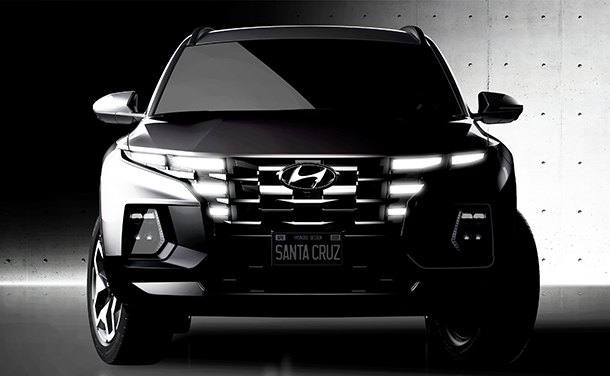Hyundai Santa Cruz Readies to Kick Some Sand
Gearing up for its debut on April 15th, Hyundai has released renderings of the Santa Cruz, its ground-breaking pickup named for a sleepy Northern California beach city.
According to Google Translate, phonetically in Korean, pickup truck is ‘pig-eob teuleog’. In the Korean domestic market, Hyundai has produced the Pony pickup of the ’80s, and more recently a small, commercial flatbed truck called the Porter. From what we’ve gathered previously, the Santa Cruz will be a unibody pickup, as is the Honda Ridgeline, but with styling more akin to that of the Subaru Brat and Baja.
Hyundai’s preferred moniker for the Santa Cruz is a sport-adventure vehicle, but in Korean, ‘seupocheu moheom chalyang’ is a real mouthful. It also is oh-so-close to BMW’s trademarked sport-activity vehicle designator that it’s easy to confuse one SAV with the other, at least by label.
Touting the Santa Cruz’s unique style, a mashup of SUV, truck, and crossover elements, Hyundai promises powerful powertrain options, a must for anything even remotely resembling a truck. A rousing debate on Facebook as to what constitutes an underpowered vehicle hopefully won’t have another model to target, if Hyundai has done its homework.
In mentioning all-wheel drive, the Santa Cruz is said to be at home in more adventurous environs than the suburbs, and no doubt given the opportunity to put that to the test, we will.
How flexible can the Santa Cruz’s open bed possibly be if it’s not able to accommodate the prerequisite plywood sheet by which all pickups are judged? While there are other trucks that aren’t able to lay plywood sheets flat to the pickup bed either, there’s no way to angle it to fit from what we’ve seen thus far. Reportedly, Hobbs Truck and Jeep Accessories in Las Vegas, Nevada, has a bed rack in development for the Santa Cruz, based on intelligence they’ve gathered overseas.
“Santa Cruz, with its bold styling, breaks open all-new segment territory, both for Hyundai and the industry as a whole. Our customers will wonder just how they managed before owning one,” said Jose Munoz, president and CEO, Hyundai Motor North America. How bold? Will the Santa Cruz create a segment within the segment?
[Images: Hyundai]
With a father who owned a dealership, I literally grew up in the business. After college, I worked for GM, Nissan and Mazda, writing articles for automotive enthusiast magazines as a side gig. I discovered you could make a living selling ad space at Four Wheeler magazine, before I moved on to selling TV for the National Hot Rod Association. After that, I started Roadhouse, a marketing, advertising and PR firm dedicated to the automotive, outdoor/apparel, and entertainment industries. Through the years, I continued writing, shooting, and editing. It keep things interesting.
More by Jason R. Sakurai
Latest Car Reviews
Read moreLatest Product Reviews
Read moreRecent Comments
- Ltcmgm78 It depends on whether or not the union is a help or a hindrance to the manufacturer and workers. A union isn't needed if the manufacturer takes care of its workers.
- Honda1 Unions were needed back in the early days, not needed know. There are plenty of rules and regulations and government agencies that keep companies in line. It's just a money grad and nothing more. Fain is a punk!
- 1995 SC If the necessary number of employees vote to unionize then yes, they should be unionized. That's how it works.
- Sobhuza Trooper That Dave Thomas fella sounds like the kind of twit who is oh-so-quick to tell us how easy and fun the bus is for any and all of your personal transportation needs. The time to get to and from the bus stop is never a concern. The time waiting for the bus is never a concern. The time waiting for a connection (if there is one) is never a concern. The weather is never a concern. Whatever you might be carrying or intend to purchase is never a concern. Nope, Boo Cars! Yeah Buses! Buses rule!Needless to say, these twits don't actual take the damn bus.
- MaintenanceCosts Nobody here seems to acknowledge that there are multiple use cases for cars.Some people spend all their time driving all over the country and need every mile and minute of time savings. ICE cars are better for them right now.Some people only drive locally and fly when they travel. For them, there's probably a range number that works, and they don't really need more. For the uses for which we use our EV, that would be around 150 miles. The other thing about a low range requirement is it can make 120V charging viable. If you don't drive more than an average of about 40 miles/day, you can probably get enough electrons through a wall outlet. We spent over two years charging our Bolt only through 120V, while our house was getting rebuilt, and never had an issue.Those are extremes. There are all sorts of use cases in between, which probably represent the majority of drivers. For some users, what's needed is more range. But I think for most users, what's needed is better charging. Retrofit apartment garages like Tim's with 240V outlets at every spot. Install more L3 chargers in supermarket parking lots and alongside gas stations. Make chargers that work like Tesla Superchargers as ubiquitous as gas stations, and EV charging will not be an issue for most users.


































Comments
Join the conversation
They'll sell a million of these things to the telephone booth relocation industry. For everyone else the devil will be in the details, ie: cab opening up to the box, in-floor storage, etc.
So if you put a bed cover on one of these you'd actually have a useful sedan with a real trunk opening. Outside of that, I don't see much use.